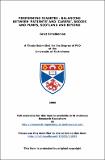Files in this item
Performing diabetes : balancing between 'patients' and 'carers', bodies and pumps, Scotland and beyond
Item metadata
| dc.contributor.author | Scheldeman, Griet | |
| dc.coverage.spatial | iii, 317 leaves | en_US |
| dc.date.accessioned | 2017-06-26T12:47:26Z | |
| dc.date.available | 2017-06-26T12:47:26Z | |
| dc.date.issued | 2006 | |
| dc.identifier | uk.bl.ethos.582145 | |
| dc.identifier.uri | https://hdl.handle.net/10023/11085 | |
| dc.description.abstract | This study is about young people (age 11-16) with diabetes. Based on fieldwork in a paediatric diabetes centre in Scotland, it describes the ways diabetes is lived and done by young people, their health carers and insulin pumps. This enactment is contrasted with other ways of doing diabetes, as observed on short fieldwork trips to paediatric centres in Brussels, Gothenburg and Boston. I explore the dynamics of diabetes care on two levels. I consider the interaction between health carers and patients. Comparative data from various paediatric centres make apparent how culturally and socially informed approaches towards adolescence, health and illness shape both care practices and patients' experiences, resulting in different medical outcomes. Concretely in the Scottish centre, a non-hierarchical holistic care approach by health carers emphasizing quality of life over health, informs the young people's perspective on diabetes. Being a free adolescent takes priority over managing diabetes, with the results of ill health and possible future complications. The existing dynamics in this care framework change as a third actor enters the scene: the insulin pump, a pager-sized technological device continuously attached to the body. I explore the balancing act between young people and their pumps. As the adolescents actively engage with their pumps not to search for better health but rather to pursue a better quality of life, the guiding question becomes: how can a technological device for insulin injection double as a tool towards a desired identity and a different illness? This work then, can be read as a concrete case study of how a uniform technological device is embedded and used in a specific cultural and social context. It can also be read as an argument for a re-orientation of paediatric diabetes care in the Scottish centre: care centred on collaboration and inclusion rather than focused on merely containing underlying conflict (between adults and adolescents, diabetes and life, health and quality of life). Centres in Brussels, Gothenburg and Boston, and the insulin pump concretely, show how collaboration can lead to good health and quality of life. To leave us to wonder: is 'doing diabetes differently' synonymous with 'doing a different diabetes'? | en_US |
| dc.language.iso | en | en_US |
| dc.publisher | University of St Andrews | |
| dc.subject.lcc | RJ420.D5S4 | |
| dc.subject.lcsh | Diabetes in youth--Case studies | en |
| dc.subject.lcsh | Diabetes in children--Case studies | en |
| dc.subject.lcsh | Diabetics--Medical care--Scotland--Case studies | en |
| dc.subject.lcsh | Diabetics--Health and hygiene--Scotland--Case studies | en |
| dc.subject.lcsh | Medical anthropology--Scotland--Case studies | |
| dc.subject.lcsh | Diabetics--Medical care--Cross-cultural studies | en |
| dc.subject.lcsh | Diabetics--Health and hygiene--Cross-cultural studies | en |
| dc.subject.lcsh | Medical anthropology--Cross-cultural studies | en |
| dc.subject.lcsh | Insulin pumps--Social aspects | en |
| dc.title | Performing diabetes : balancing between 'patients' and 'carers', bodies and pumps, Scotland and beyond | en_US |
| dc.type | Thesis | en_US |
| dc.type.qualificationlevel | Doctoral | en_US |
| dc.type.qualificationname | PhD Doctor of Philosophy | en_US |
| dc.publisher.institution | The University of St Andrews | en_US |
This item appears in the following Collection(s)
Items in the St Andrews Research Repository are protected by copyright, with all rights reserved, unless otherwise indicated.

